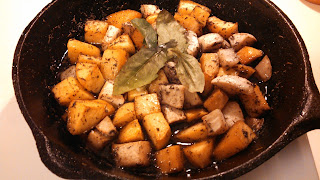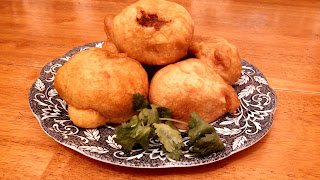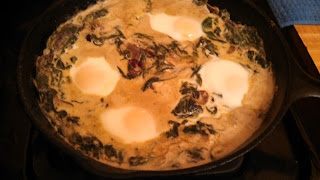Back in January 2010 I did a post on the wonders of garlic, inclusive of a recipe, Chicken with Garlic Sauce, which called for 12 garlic cloves in the ingredients. That’s right, twelve. Now, you’re saying to yourself, Twelve garlic cloves? This Rican is crazy. And, yes, guilty as charged—for garlic. I’ve decided to revisit this wondrous perennial. One can never go wrong or tire of garlic. It was use as a medicinal herb in Ancient Egypt. Greek warriors ate garlic before a battle (it increased their physical strength). Slaves ate garlic while building the pyramids since it enhanced their endurance. Think of that the next time you see the movie version of The Ten Commandments while Charlton Heston and company struggle to erect the pyramid tomb of Sethi.
It’s common knowledge that garlic promotes cardiovascular health. It has a high Vitamin C content, and prevents the accumulation of LDL (bad) cholestteral in the arteries. But more, it can reduce the chance of developing common cancers like breast and colon cancer. So, what’s there not to like about it? Yeah, I know, you’re saying, How am I gonna kiss my significan other after eating garlic? Get over it. If she or he doesn’t like it, get another partner
Cooking with garlic is the easiest thing. Crushed, chopped, minced or roasted, it gives a marvelous flavor and depth to any dish. A little garlic goes a long way, but a lot of garlic, to my mind, is better. Yes, I am a fanatic when it comes to the glorious bulb. But, as the following recipes show, garlic can enhance any dish, transforming it into a softer, sweeter, nutty-like rendition. And, you’ll never have to worry about vampires invading your home.
GARLIC BUTTER
Combine one stick melted butter with 3 cloves finely minced garlic over medium heat until the butter absorbs the garlic. Stir in one teaspoon chopped parsley, and that’s it. Great for eggs, omelets, brushed on bread or warm biscuits; or spread over steamed or baked fish, or cooked chicken. Even a juicy steak will benefit from garlic butter.
GARLIC OIL
Heat 1/2 cup sunflower oil in a small pan. Add 3 cloves crushed garlic. Cook, strring gently. for about 5 minutes until garlic is lightly golden. Do not let garlic burn or it will turn bitter. Cool, strain, and use oil as a flavoring or for frying. Very popular in Asian dishes.
GARLIC SAUCE
This is very popular in Greek cuisine. In a blender or food processor, blend 4 cloves garlic, crushed; 2-3 slices bread, soaked on water, 1/2 cup olive oil; juice of half a lemon; 1 tablespoon white vinegar; salt and ground black peppper to taste. In some recipes they add 1 cup mashed potatoes for greater consistency. Your choice. This sauce is great with cold or hot meat or fish dishes. If you like it stronger, you can add more garlic.
GARLIC POTATOES
2 pounds Idaho or Yokon Gold potatoes, unpeeled, washed and scrubbed and cut into 1/2-inch
wedges
6 tablespoons olive oil
5 garlic cloves, peeled and halved
1 teaspoon chopped fresh thyme or tarragon
1. Place potato wedges in a pan with about 1&1/2-inch water. Bring water to a boil, cover, lower heat and steam until wedges are very tender, about 15 minutes.
2. Meanwhile, in a large pan or skillet, heat 5 tablespoons olive oil over low heat. Add garlic and sauté unitl golden, about 5-6 minutes.
3. Add potatoes and thyme (or tarragon) to pan or skillet. Season with salt and pepper. Cook for about a minute more. Drizzle with ramianing olive oil and serve.
Yield: 4 servings.
OMELET WITH GARLIC
2 tablespoons olive oil
4 cloves garlic, peeled and finely minced
6 eggs, beaten
Salt and ground black pepper to taste
1 cup mushrooms (button, shitake, or portobello), thinly sliced
1/2 cup grater cheddar or Swiss cheese
1. Heat oil in medium non-stick pan or skillet over moderate heat. Manwhile, mix salt and pepper with eggs. Add to pan and cook until top begins to set.
2. Add garlic, mushroons, and cheese. Place a lid on the pan to help the top part of the omelet to cook.
3. Starting from the edge of the pan, use a spatula to fold one-third of the omelet toward center of the pan and cointinue until the omelet is roll-shaped. Cook for about 1 minute more; and slide the omelet off the pan onto a serving platter.
Yoeld: 4 servings.
SHRIMP WITH GARLIC SAUCE
1 pound medium sized shrimp, peeled and deveined
1/2 cup olive oil
4 cloves garlic, peeled and minced
Salt and ground black pepper to taste
Lemon wedges for garmish
1. Combine shrimp, olive oil, salt and pepper in a bowl or a large ziplock bag. Stir to conbine, cover (if using bowl), and marinate in the refrigerator overnight or, for at least 4 hours.
2, Heat a pan or skillet (I prefer cast-iron) on medium heat. Add butter and, when sizzling, add shrimp. Cook until pinkish red. More garlic can be added, if desired, during cooking (but don’t let the garlic burn). Serve with lemion wedges
Yield 3-4 servings.
Note : This dish is great with steamed white rice.
 The reason for his recipe is that my wife gave me a present: six prized bottles of Brunello Di Montalcino wine. This was treat. Brunello di Moimtalcino is a premium wine made in the town of Montalcino in the Tuscany region of Italy. It is made from 100% Sangiovese grapes, one of the leading grape varieties also used in making Chianti. It has a ruby red color, a highly perfumed aroma of berries and light vanilla, and bold fruit flavors.
The reason for his recipe is that my wife gave me a present: six prized bottles of Brunello Di Montalcino wine. This was treat. Brunello di Moimtalcino is a premium wine made in the town of Montalcino in the Tuscany region of Italy. It is made from 100% Sangiovese grapes, one of the leading grape varieties also used in making Chianti. It has a ruby red color, a highly perfumed aroma of berries and light vanilla, and bold fruit flavors. 4 portobello mushrooms
4 portobello mushrooms

 The archetypical Puerto Rican side dish. It’s served at breakfast with eggs and ham, at lunch, or with the evening meal whatever the entrée. It’s just plantains, sliced, and deep fried. In Puerto Rican cooking, we fry the slices twice after pressing then to form the patties. In other parts of the Caribbean, notably Jamaica, the slices are deep-fried just once. They are not pounded and re-fried. I have tried tostones this way, but it just doesn’t come out the same. Those who follow our method can acquire what is called a tostonera in any Latino market. This consists of two pieces of wood or plastic that hinge over to enclose and flatten the plantain slices. Here, again, I defer to tradition. I’ve tried these newfangled contraptions and fond them wanting. Nothing beats the plantain peels and the flat of the hand for forming genuine tostones.
The archetypical Puerto Rican side dish. It’s served at breakfast with eggs and ham, at lunch, or with the evening meal whatever the entrée. It’s just plantains, sliced, and deep fried. In Puerto Rican cooking, we fry the slices twice after pressing then to form the patties. In other parts of the Caribbean, notably Jamaica, the slices are deep-fried just once. They are not pounded and re-fried. I have tried tostones this way, but it just doesn’t come out the same. Those who follow our method can acquire what is called a tostonera in any Latino market. This consists of two pieces of wood or plastic that hinge over to enclose and flatten the plantain slices. Here, again, I defer to tradition. I’ve tried these newfangled contraptions and fond them wanting. Nothing beats the plantain peels and the flat of the hand for forming genuine tostones.






